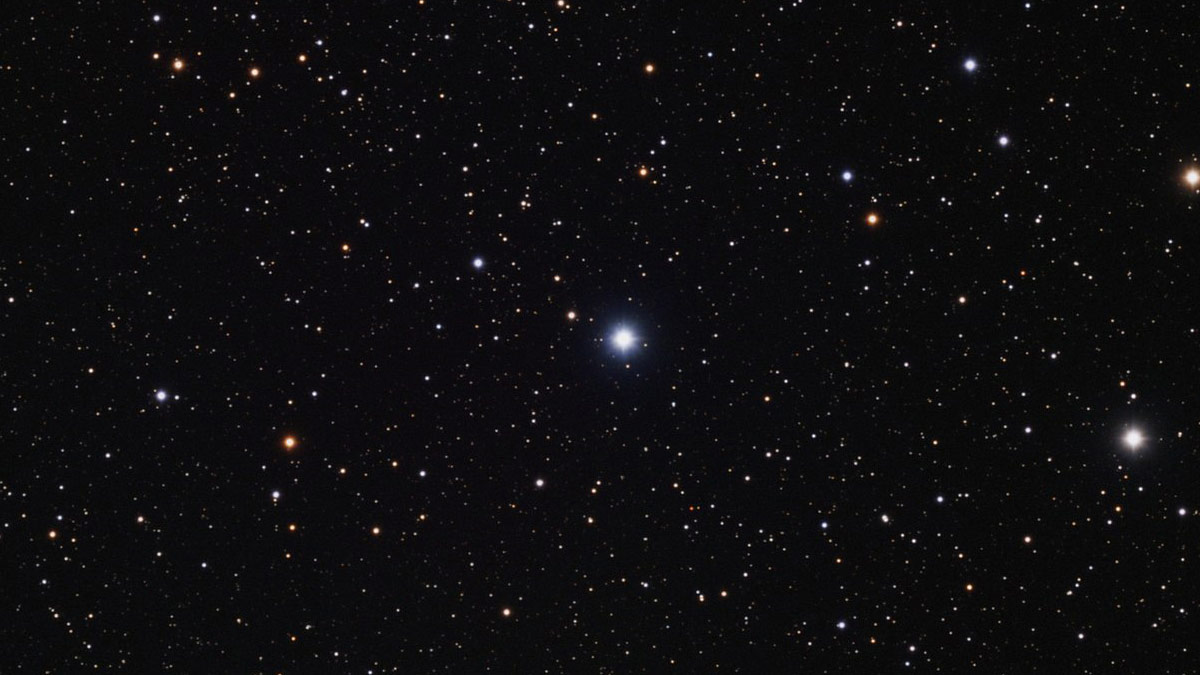Sigma Cassiopeiae is a tight binary star in the constellation Cassiopeia best viewed on crisp autumn nights.
While Sigma Cas doesn’t command the attention of other objects in this region, it remains a star worthy of our admiration. For starters, it’s a rewarding tight double to split in a telescope; one must use higher power to make this binary visible. Also, it appears this binary has a way of playing games on our eyes. Specifically, depending on the observer, the colors of the two stars may appear different. Observers in the past have recorded everything from “smalt” blue to white to even red. (See my historical description section below). In general, most observers will see a bluish-white, which agrees with the hotter temperature of these stars.1
According to Jim Kaler, the primary star, called Sigma A, is 10 times the radius of our sun, while the secondary, Sigma B, has a radius 4 times larger. Also, Sigma A spins at a velocity of around 182 kilometers per second, making a full rotation in under 2.7 days.1
My Observations
| Date | October 1, 2022 |
| Time | 10:30 p.m. |
| Location | Seattle, WA |
| Magnification | 338x |
| Scope | Meade 8″ SCT |
| Eyepiece | 12mm+2x Bar. |
| Seeing | Good |
| Transparency | Good |

This is a tight double that is playing games with its colors. Looking at it with an 8mm eyepiece, it appears bluish in nature. However, I just attached a 2x Barlow to my 12mm eyepiece, and now the primary is a slightly larger star and still has a blue tinge, while the secondary appears a warm white, perhaps beige. While the skies are clear with good transparency, the secondary star “shimmers” in and out of focus tonight.
Key Stats
| Constellation | Cassiopeia |
| Best Viewing | Autumn |
| Visual Magnitude | +5.0, +7.2 |
| Absolute Visual Magnitude | -3.47 |
| Separation | 3.1 ″ | 1500 AU |
| Position Angle | 326° |
| Spectral Class | A=B1, B=B3 |
| Distance from Earth | 1,500 ly |
| Milky Way Location | Orion Spur |
| My Viewing Grade | B |
| Designations | SAO 35947, σ Cassiopeiae, σ Cas, HIP 118243, Σ 3049, Struve / STF 3049 |
Historical Descriptions
Observation by astronomer Admiral William H. Smyth
“A beautiful double star on the lady’s left elbow, and one degree south of [NGC 7789], which lies . . . between σ [Sigma] and ρ [Rho]. “A” 6, flushed white; “B” 8, smalt blue; the colours are clear and distinct, though less fine than those of ε Boötis, of which this is a miniature.”2
Observations by Sir William Herschel on August 31, 1780
He described the primary as “w. [white] a little inclining to r. [red]” and the secondary he called “dark,” which in his usage seems to have meant dusky or red.2
Sources and Notes
Banner shared under the Creative Commons Attribution-Share Alike 4.0 International license. Photo by David Ritter. Details here.
1 Sigma Cassiopeiae, http://stars.astro.illinois.edu/sow/sigmacas.html.
2 “Sigma (σ) Cassiopeiae: A Smalt Blue Jewel on the Lady’s Shoulder.” Star-Splitters, June 16 2014, https://bestdoubles.wordpress.com/2012/01/07/sigma-%CF%83-cassiopeiae-a-smalt-blue-jewel-on-the-ladys-shoulder/.
Sketch by Wayne McGraw
